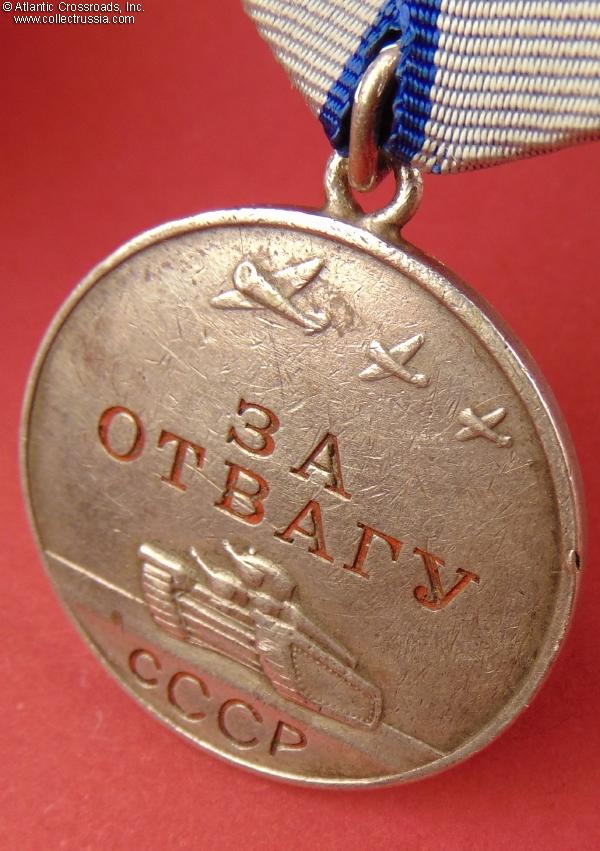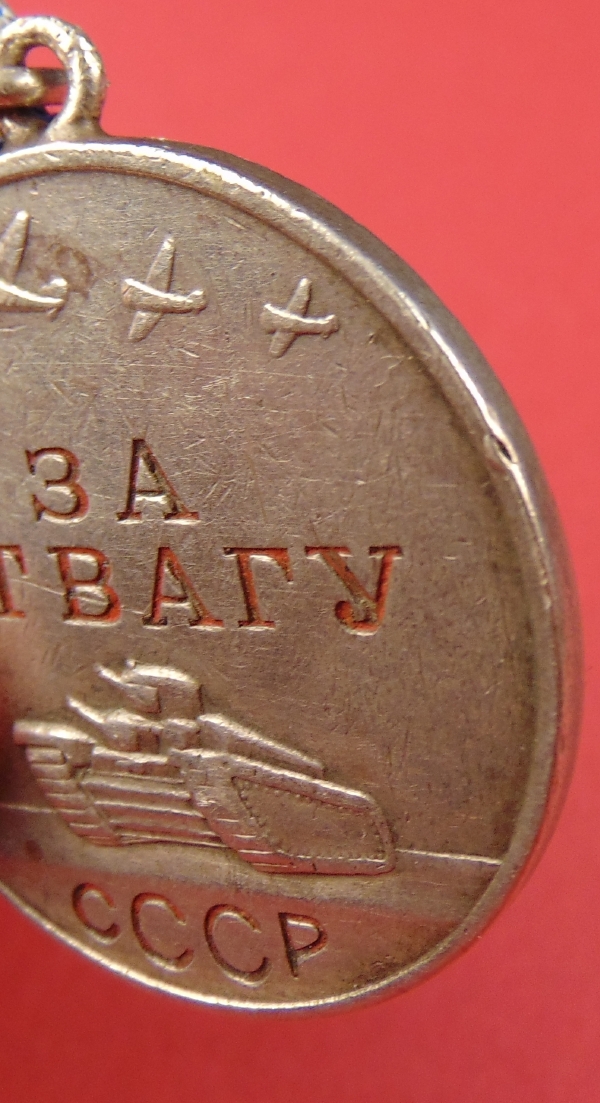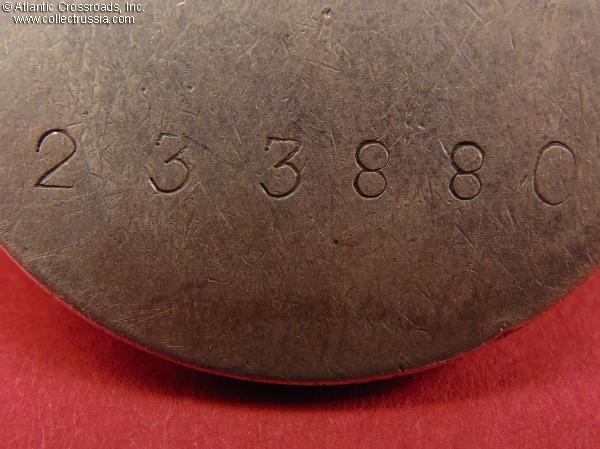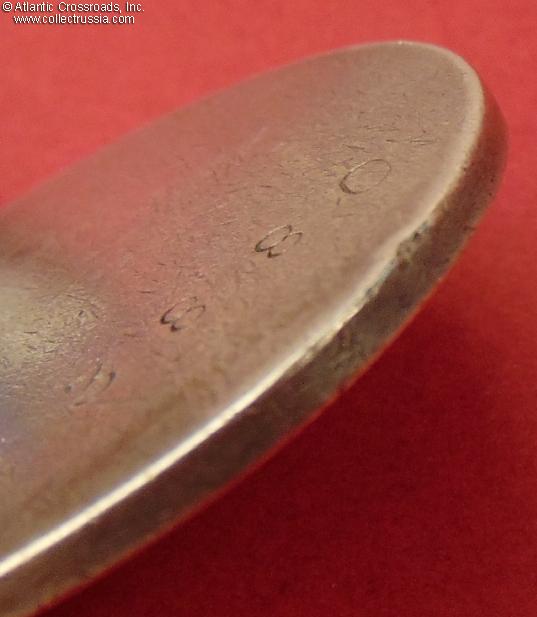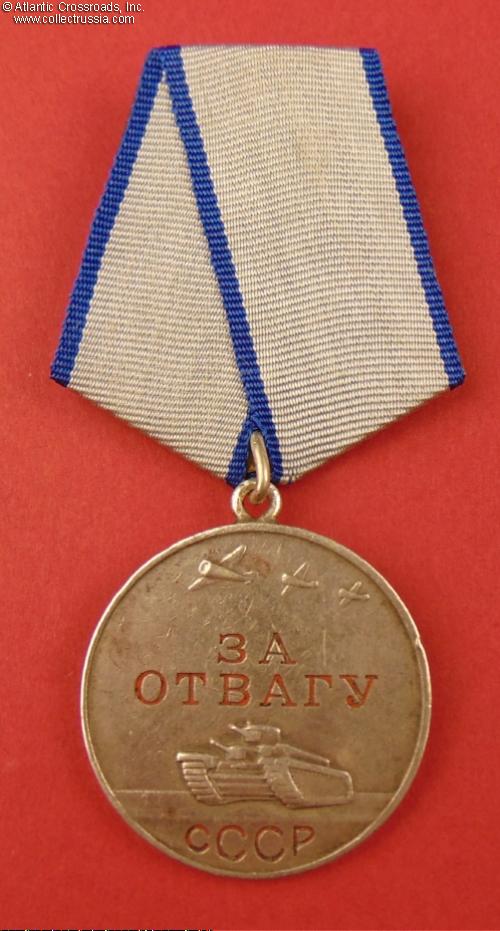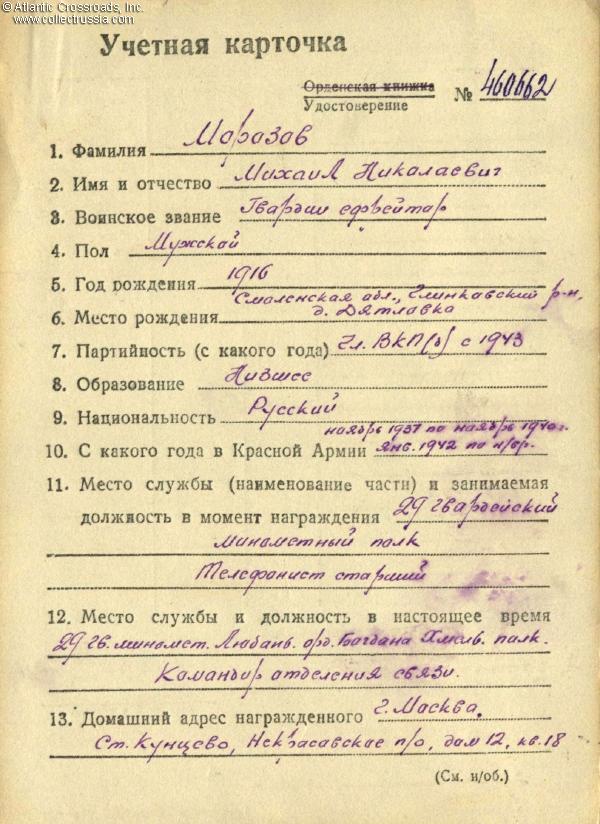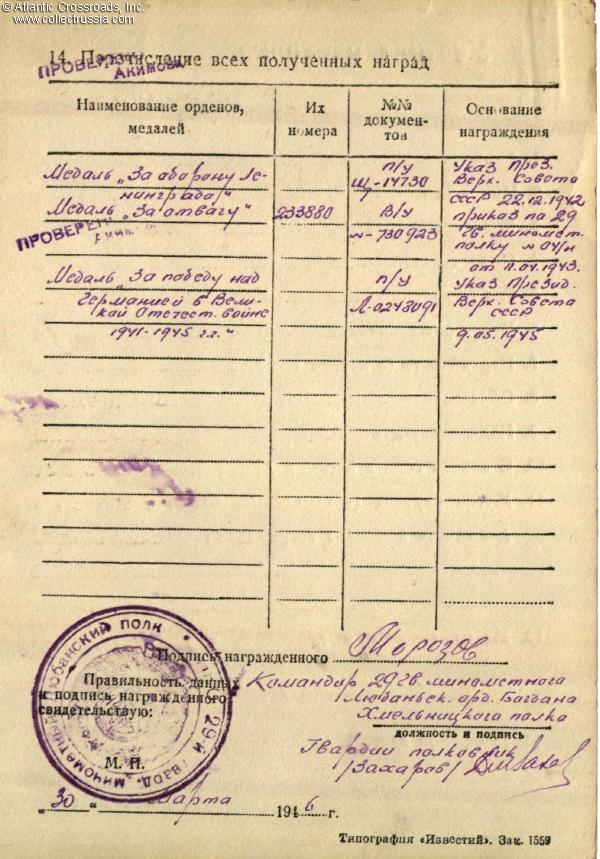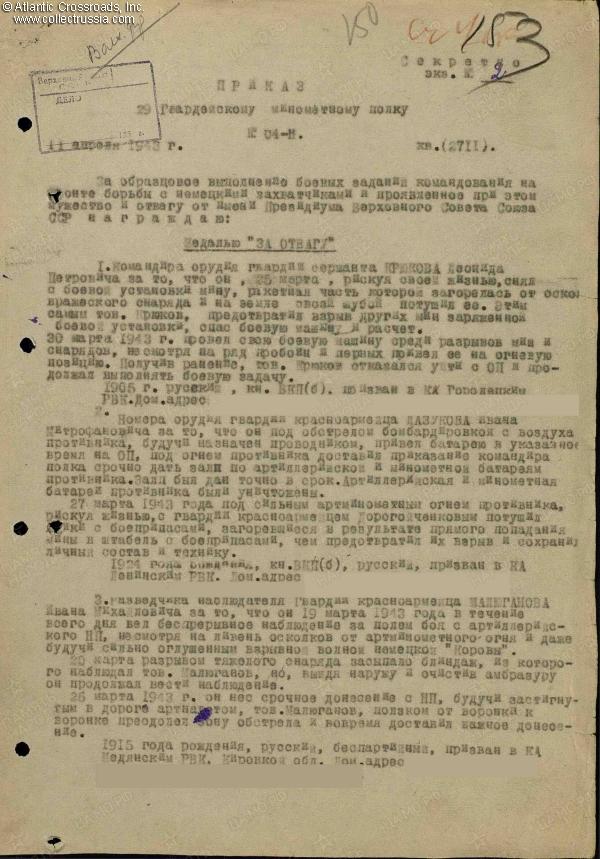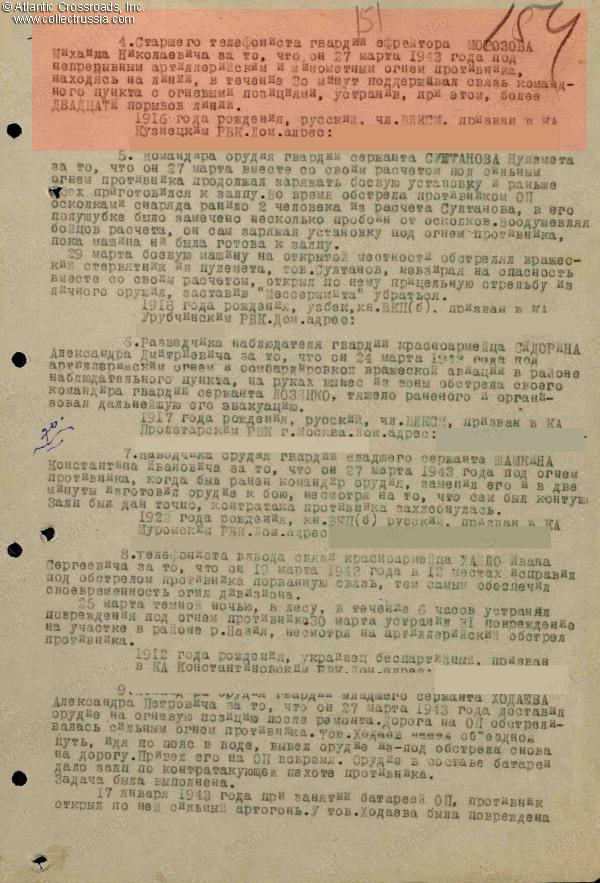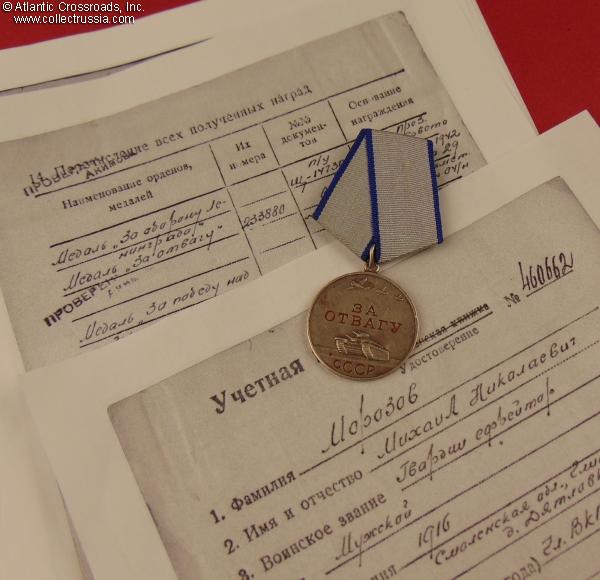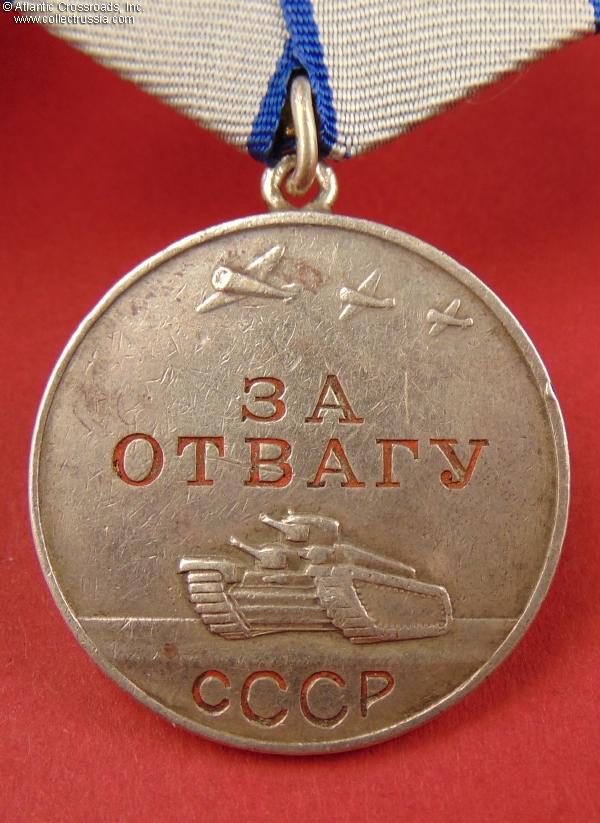
Medal for Valor, Type 1 Variation 3, "Thin" sub-variation, on a Type 2 suspension, #233880, awarded on 11 April 1943 to Guards Corporal Makhail Morozov (Михаил Николаевич Морозов), a senior telephone operator of the 29th Guards Mortar (Multiple Rocket Launcher) Regiment.
The medallion is in silver and lacquer; measures 42.0 mm in height incl. eyelet, 37.3 mm in width, approx. 2.0- 2.2 mm thick at the edge (the so-called "Thin" sub-variation); weighs 25.1 g not including the suspension and connecting link.
Very fine to excellent condition. Most of the fragile original lacquer in the letters is still present, which is quite uncommon: it is usually completely missing or replaced on wartime Medals for Valor, especially of the early type. There are just a couple of minuscule dings to the edge, no significant bumps. The medallion has many tiny contact
The medallion is in silver and lacquer; measures 42.0 mm in height incl. eyelet, 37.3 mm in width, approx. 2.0- 2.2 mm thick at the edge (the so-called "Thin" sub-variation); weighs 25.1 g not including the suspension and connecting link.
Very fine to excellent condition. Most of the fragile original lacquer in the letters is still present, which is quite uncommon: it is usually completely missing or replaced on wartime Medals for Valor, especially of the early type. There are just a couple of minuscule dings to the edge, no significant bumps. The medallion has many tiny contact marks that are barely noticeable to the naked eye but no significant scratches, nicks or edge knocks. The raised details of the tank and airplanes are very well preserved.
The medal comes on a Type 2 suspension device, an early post-war model in brass, a replacement for the original Type 1 that had become obsolete in 1943. The ribbon is new. The connecting link appears to be of the period.
Mikhail Morozov was born in 1916 in a village of the Smolensk region. He served a stint in the Red Army from 1937-40 and reenlisted in January 1942. As of spring of 1943, he had the rank of Guards Corporal and was serving as a senior telephone operator with the 29th Guards Mortar Regiment (the "Guards Mortars" being the Soviet codeword for the famous Katyusha multiple rocket launcher units, aka "Stalin's Organs"). During the previous year, his unit was deployed southeast of Leningrad, providing support for the unsuccessful early attempts to break the German blockade in the areas of Pogostye and Sinyavino. In early 1943, it was attached to the 55th Army of the Leningrad Front and in March of that year, re-subordinated to the 8th Army of the Volkhov Front, both heavily engaged in extremely bloody and largely futile attacks aiming to dislodge the Germans from their strong positions in the area of Sinyavino Heights and railway station of Mga.
The new major Soviet offensive in the area, codenamed Polyarnaya Zvezda ("Polar Star") by the Soviet high command (aka Krasnobrodsko-Semerdynskaya Operation), was planned under the overall command of Marshal Zhukov. It started on 19 March 1943 and after its first three days, the 8th Army was seemingly making progress, having broken through the German 18th Army defenses on the 8-km front near Voronovo. On 27 March, just as the battle was reaching its climax, Morozov distinguished himself in action by providing uninterrupted telephone connection between his commander and rocket launcher firing positions. Under unceasing enemy mortar and artillery fire, he within 30 minutes repaired over 20 breaks in the telephone lines. On 11 April, Morozov was awarded for this feat with the Medal for Valor by a general order of the 29th Guards Mortar Regiment.
By that time, the Soviet offensive had failed despite all the efforts and had been called off. In the end, the 55th and 8th Armies had gained a few kilometers of ground and cut the Mga railroad at an enormous cost in human lives - some 150,000 casualties - without achieving any kind of significant success. The German 18th Army suffered only limited losses by comparison, under 30,000 men (including approx. 9600 killed or missing). Because the operation was rightfully deemed a disaster by Marshal Voroshilov in his post-operation report to Stalin - despite local Soviet command's claims to the contrary - awards for this battle are quite scarce.
Although Morozov remained on active duty through the rest of WW2 and beyond, the Medal for Valor remained his only decoration of the war (beside the medals for the Defense of Leningrad and Victory over Germany). As of March 1946, he still had the rank of Guards Corporal and was serving as a signal squad commander in the same unit, at that point in time stationed in Moscow.
Research Materials: b/w photocopy of the award record card and award decree containing a brief citation. A history of the 29th Guards Mortar Regiment is available on several Russian-language websites.
$195.00 Add to cart


